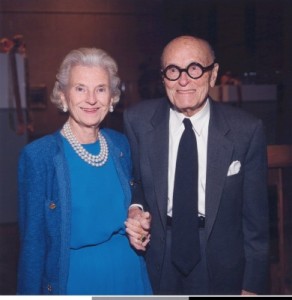 Last Friday, demolition began on the Ruth Carter Stevenson home, an award-winning house of mid-century design at 1200 Broad Avenue in Fort Worth. The demolition began just as preservationists started working to try and save the historic house, designed in the 1950s by architect Harwell Hamilton Harris, with landscape by Thomas Church.
Last Friday, demolition began on the Ruth Carter Stevenson home, an award-winning house of mid-century design at 1200 Broad Avenue in Fort Worth. The demolition began just as preservationists started working to try and save the historic house, designed in the 1950s by architect Harwell Hamilton Harris, with landscape by Thomas Church.
Ruth Carter Stevenson, daughter of the publisher Amon G. Carter, commissioned the house for her young family in 1955. The fate of the home was in question after her death last January, but it was sold in April to Fort Worth residents Ardon and Iris Moore, although not much was known about their plans for the property. Since the demolition began, though, the Moores have been referred to in many articles, editorials, and blogs as “phililistines,” sometimes injecting the adjective “brazen.”
Architect Sandra Dennehy, of the Fort Worth Chapter of the American Institute for Architects gives her take on the unfortunate timing:
I can only speculate that Mr. Ardon Moore, the new owner, was alerted to the groundswell of concern over his intention of taking the home and gardens down when the Star-Telegram tried to get in touch with him on Thursday for comment… and not wanting to get embroiled in any kind of controversy, he fast-tracked the demolition… again, my speculation only, but seems too coincidental for me to think otherwise.

Ruth Carter Stevenson and Amon Carter Museum designer Philip Johnson. Photo: Texas Society of Architects
Having served on the board of the Fort Worth Art Association since age 26, Carter Stevenson was also familiar with architects and hired Harris, who was then dean of the architecture school at the University of Texas in Austin. It was about this time that she also met Philip Johnson, who was in Texas for the completion of the Menil Foundation’s University of St. Thomas structures. She took the opportunity to invite Johnson to design a museum for the Amon Carter Collection.
Among the many arts and architecture organizations which she founded or served with as board member, Carter Stevenson was the first woman to serve on the board of the National Gallery of Art and was its first female chair. In 1992, she endowed the Ruth Carter Stevenson Regents Chair in the Art of Architecture at the University of Texas. She was committed to the arts, architecture, and historic preservation. So, “Why,” wonders Dennehy, “did Ruth Carter Stevenson not safeguard her beloved home in some way, by either an Historic Designation or leaving the home to a foundation?”
According to the Star-Telegram, Sheila Johnson, Stevenson’s oldest daughter, said the heirs were unaware that her mother’s house would be demolished shortly after being sold, but she said she doubted if any relatives would have opposed its destruction.
The city of Fort Worth could do nothing legally to prevent demolition since none of the owners ever applied for historic landmark status. “Respecting the history and the roots of our city and its architecture are very important to me and to the City of Fort Worth,” Mayor Betsy Price said in a statement. “However, we also must respect the rights of property owners. There is a process in place for identifying and designating historic properties, but the property owners did not take any action to begin that process. Therefore, no action has been taken.”
Dennehy suggests that the mayor’s statement should be reversed to read, “While Texas is a property rights state, it is unfortunate that the new owner does not understand the significance of this property and respect it and Ruth Carter Stevenson has done for our City, and want to preserve it.”
While Dennehy does not refer to the Moores as philistines, she does call their actions “arrogant.” She ends her statement: “The lesson here is for us to be more pro-active and more cooperative amongst organizations that have at their core the same objectives.” The “us” in the statement may refer to AIA architects, cultural historians, Fort Worth art lovers, mid-century Texans, or anyone who objects to such a landmark being erased so quickly and so easily.
(Architecture buffs: For tons of images from the architect’s personal slide collection of the Ruth Carter Stevenson House [also known as the J. Lee Johnson and Ruth Carter Johnson Residence], visit Triangle Modernist Houses.)



1 comment
Unbelievable, Mr. Ardon Moore.